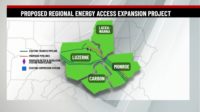Natural Gas Infrastructure
NJ Utility Earmarks $902M to Upgrade Aging State Gas Lines

Public Service Electric & Gas plans to spend $902 million to exstend for two years a program to modernize 400 miles of aging gas mains throughout New Jersey. But funding approval it requested earlier this year from the state Board of Public Utilities to launch plans soon for renewable gas and hydrogen pilot projects was ere delayed by the regulator at least until 2026.
Under the current plan, work will begin in January and continue to December 2025, but the utility did not have a timetable for when contract procurement would begin, says Lauren Ugorji, a utility spokesperson.
“We’re in the process of finalizing the exact list of municipalities and have not gone to bid for contractors,” she says. PSE&G services 18 counties in New Jersey.
In its Oct. 11 order, BPU said PSE&G “agreed to defer action on its third phase.” Its components would now be reconsidered in a process that must start by the beginning of 2025.
“Continuing this work that reduces methane emissions and enhances the reliability of our gas system is critical,” Kim Hanemann, PSE&G president and chief operating officer, said in a statement.
As part of the planned third phase, a proposed renewable natural gas facility would inject processed landfill gas into PSE&G’s gas distribution system, improving air quality and reducing pollutants, the utility said
The third phase of the project "builds on the Middlesex County Utilities Authority’s continued success in reclaiming landfill gas, and could become a model for others working to reduce greenhouse gas emissions,” said John Wiley, authority chairman, in the PSE&G announcement.
The plan also includes installation of a 1-MW-rated electrolyzer to supply 2% hydrogen as part of the gas distribution system, with a goal to reduce what the utility estimated said would be 1,000 metric tons of carbon dioxide equivalent annually.
Newly appointed BPU President Christine Guhl-Sadovy said PSE&G will replace the cast-iron gas and steel pipelines with leak-proof infrastructure in 2024 and 2025. About 1.9 million gas customers could see a $3.51 monthly bill increase at the end of the program in 2025, said the regulator.
Nearly 1,800 miles of gas line have been replaced in recent years, says PSE&G, which said it is the U.S. utility with the largest proportion of aging cast iron pipes, many up to 100 years old.
An estimated 310 miles, or 38%, of low-pressure cast iron pipe upgrades in the third-phase program would be in municipalities with a "significant number" of overburdened communities, said the utility.
PSE&G also said it reduced methane emissions by about 300,000 metric tons between 2011 and 2022, spending more than $2 billion on the effort.
An executive order issued earlier this year by Gov. Phil Murphy (D) directs New Jersey to transition from fossil fuels to 100% clean energy by 2050, with system decarbonization to reduce reliance on natural gas among strategies in the state’s energy master plan.
BPU was directed to conduct a comprehensive review of the future of the natural-gas sector as part of the envisioned transition, with findings set to be issued next August.
Meanwhile, southern New Jersey, along with Delaware and southeastern Pennsylvania, has been selected by the U.S. Energy Dept. to launch a hydrogen hub that would generate cleaner fuel developed from both fossil-fuel and nuclear energy sources over the next decade.
Public Service Enterprise Group Inc., PSE&G's parent and a member of the hub team, will host its third quarter earnings call on Oct. 31.


